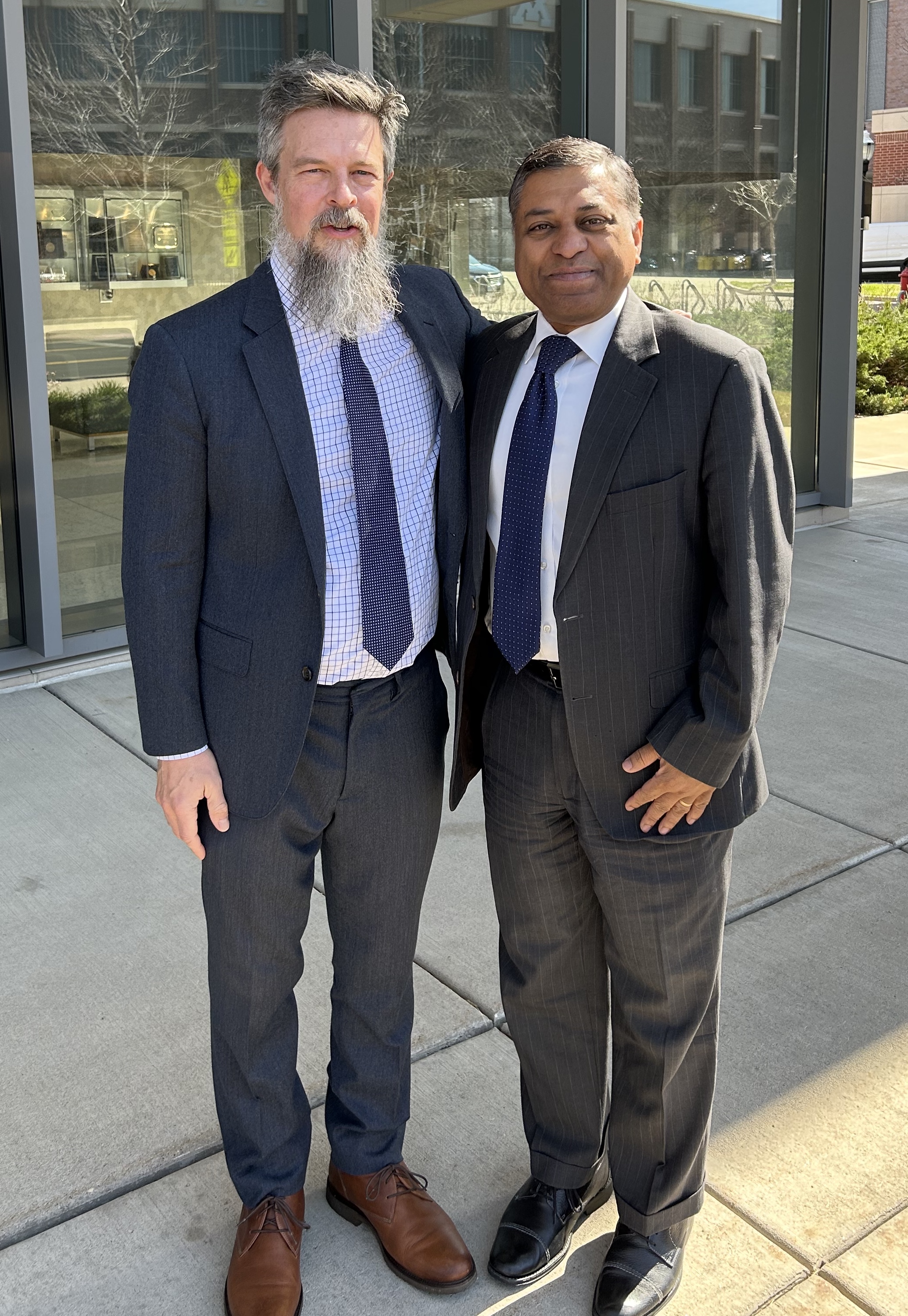
News & Events
2023 Center for Neural Circuits in Addiction Pilot Awards
The awardees for the Center for Neural Circuits in Addiction’s Pilot Program have been named. This year the Center opened the funding opportunity up to graduate students and postdocs and provided awards of $15,000 to allow for more projects to be funded. In response, we received more submissions than any other year to date.
Though we were not able to fund all of the proposals, we did manage to allocate funding for 11 projects. See the full list of awarded projects below: Thank you to all who submitted!
Cecilia Barajas, George Wilcox, and Carolyn Fairbanks: “Agmatine mediated inhibition of opioid induced conditioned place preference”

Cece is investigating agmatine, a mild NMDAR antagonist, that has been shown to mitigate the rewarding properties of opioids while still providing pain relief. Her preliminary data demonstrated that agmatine pretreatment inhibited acquisition of oxycodone self-administration compared to saline pretreated animals. In addition, the agmatine pretreatment group exhibits less cFos expression in the nucleus accumbens than controls.
Cece’s pilot will expand upon these results with two aims: Aim 1: determine the impact of agmatine on oxycodone-induced conditioned place preference (CPP) and Aim 2: determine specific neuronal types and circuits involved in the agmatine mediated inhibition of opioid induced reward behavior.
For this project she will partner with the Structural Circuits Core. The group will use CPP experiments with FosTRAP2 transgenic mouse line to fluorescently label activated neurons. The labeled brains will then undergo tissue clearing to create a 3D rendering of the mouse brain and visualize the impact that agmatine has on opioid induced activation of neural circuits throughout the brain’s reward system. They hypothesize that agmatine pre-treatment will reduce the expression of tdTomato in NAc, dopaminergic VTA neurons, and glutamatergic neurons in the PFC, BLA, and hippocampus.
Ajay Extross and Daniel Schmidt: “high efficiency scaffolded dual AAV gene delivery vector for cell type-specific manipulation of neural circuits”

Ajay is working on the development of new methods to increase the efficiency of AAV payload delivery to targeted neuronal subtypes. Currently one of the primary methods of achieving cell subtype specificity is through cell specific promoters. The limited payload availability of AAV and the large size of these promoters often necessitates dual-AAV delivery schemes to deliver larger payloads which brings additional complications.
Ajay and Daniel hypothesize that by “physically linking AAV encoding for a multi-part cell type-specific payload onto a scaffolding strand, we can dramatically increase co-transduction efficiency and therefore efficacy and safety of genetic manipulation of addiction-relevant neural circuits in vivo.” Ajay will partner with the Viral Innovation Core to complete this project that will, help expand the possibilities of all researchers using viral delivery methods to investigate neural circuits.
Edith Hernandez and Sade Spencer: “Assessing the impact of oral metformin on glutamatergic activity driving cocaine relapse behavior in the nucleus accumbens core”

Edith will explore the potential therapeutic potential for metformin in cocaine use disorder. Previous studies from the lab have demonstrated that metformin administered directly to the NAcc decreases self-administration during reinstatement in rats. Since metformin potentiates glutamatergic activity and glutamate dysfunction has been shown to play a role in reinstatement, Edith will investigate glutamate release in the NAcc following orally administered metformin in a cocaine reinstatement model.
To assess glutatmate release during reinstatement behavior, Edith will utilize two of the Centers cores, the Imaging Cells During Behavior Core(ICBC) and the Viral Innovation Core (VIC). The VIC will provide AAV packaging and delivery of iGluSnFR3, a fluorescent Glu sensor. To image the glutamate driven fluorescence levels during self-administration, extinction and cue-induced reinstatement, ICBC will assist the lab with fiber photometry. The lab predicts that “metformin will provide moderate glutamate increases, rescuing cocaine-induced depletion during withdrawal and effectively lowering cue-induced cocaine reinstatement.”
Suhasa Kodandaramaiah, PhD; Lucy Vulchanova, PhD; Daryl Gohl: Robotag-Seq: Robot assisted cellular barcoding for transcriptome-wide single-cell sequencing of identified cell populations in intact tissue

Dr. Kodandaramaiah will be leading a group seeking to improve transcriptome single cell sequencing by increasing the efficiency of coupling transcriptomics with functional analysis of the cell. Currently, integration of single cell transcriptomics and functional analysis is labor intensive with minimal throughput. Suhasa’s group has noted that “Contemporary methods for single-cell transcriptomics lack the ability to integrate spatial information with transcriptomic measurements at scale. For instance, in-situ hybridization, sequencing, or capture approaches are generally unable to conduct large-scale transcriptome-wide measurements at cellular resolution and/or they are depth limited to only analyzing cells near the tissue surface. An approach that can identify specific populations of cells in particular brain regions, and allow transcriptome wide profiling of these cellular populations in a spatial resolved fashion would be transformational.”
Their new technique uses a robotic microinjector to target specific labeled cell populations with the ability to tag 100s of cells with a DNA barcode in a single preparation. During subsequent transcriptomic profiling of dissociated cells or isolated nuclei from the injected tissues, the injected barcodes can be used to relate the transcriptomes with the pre-identified cells thereby achieving large-scale, transcriptome-wide sequencing at cellular resolution. Suhasa’s group will be working with the Imaging Cells During Behavior Core to further develop this technique.
Anna Lee, PhD: Alcohol activation of brainstem cholinergic projections

Dr. Lee will be investigating the different roles of cholinergic neurons following alcohol exposure based on their anatomical target, rewarding versus aversive doses of alcohol, and sex. Previous research has shown that cholinergic neurons in the mesopontine tegmentum (MPT) can impact alcohol seeking behavior in mice. However, additional studies suggest that their role is nuanced. Anna’s preliminary results suggest that alcohol activation of MPT cholinergic neurons depends on the dose, administration regimen, and sex of the mouse. For instance, acute aversive doses (4 g/kg i.p.) of alcohol activate these neurons, but for a rewarding dose (2 g/kg i.p.) to activate MPT neurons, alcohol exposure must be extended to 15 days. In addition, this rewarding dose activation is seen in males but not females. The role of different populations of MPT neurons with different projection targets is also unclear. Some research suggests activation of cholinergic projections to the VTA increases alcohol seeking, but the MPT also projects to the habenula, nucleus accumbens, substantia nigra, and interpeduncular nucleus. It is unclear what role these additional projections may play in alcohol seeking behavior.
The lab has speculated that different projection neurons may mediate the differential acute aversive response compared to the response seen following 15 days of a rewarding dose. Specifically, they hypothesize “that rewarding concentrations of alcohol activate MPT cholinergic neurons that project to the VTA and nucleus accumbens, whereas aversive doses will activate MPT cholinergic neurons that project to the VTA and habenula.”
Anna will collaborate with the Viral Innovation Core and the Structural Circuits Coreto test their hypothesis and try to identify additional sex differences in these projection neurons in response to alcohol. Anna describes the importance of the core's contributions below:
"The VIC will be engaged in the design and the production of the AAV-ChATDIO-GFP that will be micro-injected into the MPT of TRAP2 mice. The expertise of the VIC will also be consulted for 4-hydroxytamoxifen activation of the CreTM, leading to expression of GFP in activated MPT cholinergic neurons. The SCC will be engaged in the processing of the mouse brains, as their expertise and resources will be critical for the brain clearing step, followed by 3D imaging to identify MPT cholinergic projections. This project will not be possible without the participation of these two cores."
Emilia Lefevre, PhD: Modulation of selective excitatory input to NAC PV interneuron synaptic connections

Dr. LeFevre will investigate how modifying inhibitory interneurons in the nucleus accumbens (NAc) impacts relapse in mice with previous opioid self-administration exposure. Her previous research has demonstrated that DREADD inhibition of NAc parvalbumin (PV) interneurons blunts cue-induced reinstatement in a fentanyl self-administration paradigm. Since these PV interneurons receive input from various corticolimbic regions, Emilia’s next step is to start teasing apart the impact of various PV interneuron inputs on behavior. Her first target will be the inputs from the basolateral amygdala, a region already implicated in reinstatement behavior.
For this project Emilia will partner with the Viral Innovation Core to implement a novel tool termed the ‘Optical Synapse’. “Luminopsins control synaptic connectivity utilizing presynaptically originating bioluminescence to activate optogenetic actuators expressed at postsynaptic sites. The presynaptic luciferase generates the light needed to activate post-synaptic opsins (excitatory or inhibitory) when its substrate luciferin (coelenterazine, CTZ), is bound. CTZ can be delivered intravenously through jugular catheters, thus circumventing the need for delivery of external light to the brain. For neuronal inhibition, I propose using the Renilla luciferase coupled with a light-driven chloride pump, Natronomonas halorhodopsin that was previously shown to impact behavior for over 1hr following CTZ administration.” Emilia predicts that inhibiting the BLA input to the PV interneurons interneurons will decrease cue-induced reinstatement.
Emilia comments below on the importance of the Center cores and the MDTA Works-In- Progress sessions in the development of this project:
"This project will require the expertise and services of the Viral Innovation Core. In my most recent MDTA Works-in- Progress presentation, I had put forth the question, how could I modulate selective presynaptic inputs to a specific cell-type during behavior? This led Dr. Marron to suggest the use of luminopsins, which are still a relatively novel tool for neuromodulation and not all are commercially available. A consultation with the VIC confirmed that they will be able to produce the viral vectors described in this application, as well as the production timeline (˜2 months). This project meets the goals of the Viral Innovation Core to develop new AAV based tools that overcome the limitations of the tools I previously had available to me."
Ana Manea, MSc.; Leyla Brucar, MSc.; Anna Zilverstand, PhD; Jan Zimmermann, PhD: From Nonhuman Primates to Humans: Translational Neuroimaging-Based Biomarkers of the Dopaminergic System Across the Stages of Cocaine Addiction

Ana Manea (pictured left) and Leyla Brucar, both MDTAgraduate students, will be collaborating with the Addiction Connectome Core to develop neuromelanin-sensitive magnetic resonance (NM-MRI) techniques at the UMN. NM-MRI is an imaging technique that allows for imaging of neuromelanin, a metabolic product of cytosolic dopamine, and the technique has been validated as a proxy measure for dopamine function in the brain.
Recently researchers have also demonstrated that NM-MRI signals in the substantia nigra are increased in individuals with cocaine use disorder compared to controls. However, these were human studies in individuals with a history of cocaine use. Ana and Leyla will be investigating the impact of cocaine on DA levels using the NM-MRI technique in a longitudinal animal study. This will allow them to look at within subject levels at multiple timepoints in the addiction model cycle (naïve, onset, maintenance, extinction, and reinstatement).
In addition to NM-MRI the group will also assess functional connectivity at these timepoints using standard fMRI techniques to determine whether DA-related anatomical changes are predictive of changes in BOLD-derived striatal functional connectivity. The relationship between NM-MRI findings and functional connectivity in cocaine use disorder, is still not clear due to the lack of longitudinal studies. As described by the authors, “the overall objective of this project is to identify neuroimaging-based biomarkers of DA change across the stages of addiction in NHPs and investigate whether these biomarkers ‘translate’ to humans with current CUDs.”
Michael Raleigh, PhD and Carly Baehr, PhD: Neuropharmacology of methamphetamine enhancement of fentanyl-induced respiratory depression

Drs. Michael Raleigh (pictured left) and Carly Baehr will be investigating the impact of methamphetamine on fentanyl induced respiratory depression. Preliminary data from the group has shown that methamphetamine increases the respiratory depressive effects of fentanyl in a dose-dependent manner as measured via pulse oximetry.
The group is now developing a calcium imaging assay within the pre-Bötzinger complex (preBötC), an area implicated in opioid mediated respiratory depression, to explore the mechanism mediating this amphetamine induced potentiation of respiratory depression. Michael and Carly will partner with the Viral Innovation Core and the Imaging Cells During Behavior Core for the development of this assay. The VIC will provide viral vectors to selectively induce expression of fluorescent calcium indicators in the preBötC. For photometry, the ICBC will assist in implanting optic fibers in the preBötC to measure calcium levels as a proxy of neuronal activity. With this assay, the group will measure neuronal activity within the preBötC along with oxygen saturation following fentanyl exposure with and without methamphetamine.
The group hypothesizes “methamphetamine will enhance fentanyl induced reduction in calcium signaling at higher doses, and that this will be associated with lower percent oxygen saturation (as measured via pulse oximetry).” These initial studies and development of this assay within the preBötC will help provide insight into the degree methamphetamine enhances the potency of fentanyl and also open the door to further experiments exploring the phenomenon.
Lauren Slosky, PhD and Ezequiel Marron Fernandez de Velasco, PhD: Mapping of neurotensin receptor 1-expressing projections to the nucleus accumbens

Drs. Slosky (pictured) and Marron Fernandez de Velasco will be further investigating the mechanism of action for their newly developed compound (SBI-553). SBI-533 is an allosteric neurotensin1 receptor (NTSR1) agonist stimulating beta-arrestin activation without perturbing normal NTSR1 G-protein signaling. SBI-533 has been shown to inhibit methamphetamine induced increases in locomotor activity, conditioned place preference, and self-administration without impacting hypothermia or hypotension (common responses to NTSR1 G-protein activation). The nucleus accumbens (NAc) is the only region identified to date to mediate the inhibitory effects of NTSR1 ligands on drug behaviors.
While the receptor target and downstream effects of SBI-533 are relatively well known, the cellular location of NTSR1s and the general circuit mediating its effects on methamphetamine is unclear. Partnering with the Viral Innovation Core (VIC) and the Structural Circuits Core, Lauren and Ezequiel will identify the circuit(s) mediating the response of SBI-533 in the NAc.
The group will partner with VIC in the development of retrogradely transported AAVs to use in the lab’s NTSR1-Cre mouse line. An AAV2retro driving Cre dependent expression of an axon terminal localized red fluorescent protein and a nuclear localized GFP will be injected in the NAc of adult NTSR1-Cre male and female mice. Following time for expression, these mice will then be sacrificed, and SCC will clear the tissue of collected brains and image using lightsheet fluorescence microscopy to identify the cellular localization of NTSR1 in the NAc. The group expects to identify NTSR1-expressing terminals with origins in multiple brain regions, including the VTA and cortex.
In addition to the localization of NTSR1 in the NAc, behavioral effects of impacting NTSR1s localized to axon terminals in the NAc will be assessed through viral mediated, pathway specific, conditional deletion. Following deletion, locomotor activity will be measure in mice following administration of methamphetamine with and without SBI-533 pretreatment. The group expects “selective deletion of NTSR1 from terminals in the NAc to render SBI-553 ineffective at blocking meth-induced locomotion.”
Margaret Stelzner: Brain-wide characterization of VTA GABA neuron projections

Margaret Stelzner, an MDTA graduate student in the Saunder’s lab, will investigate the different types of GABA neurons in the VTA. Within the VTA there are multiple classes of GABA neurons. For instance, one group with local projections and another with distal projections to areas such as the nucleus accumbens, habenula, and the ventral pallidum. The GABA neurons can also be categorized by their distinct expression of parvalbumin, GAD1, or MDLX, and these expression-based subtypes also appear to have distinct anatomical patterns. Margaret notes that “there is overlap of these expression patterns suggesting that specific GABA subtypes have unique projection target ratios and this GABA marker heterogeneity contributes to the duality in motivated behavior via engaging neuronal circuits to various degrees.”
Partnering with VIC and SCC, Margaret will attempt to identify the organization of these different types of GABA neurons within the VTA. Using viral vectors to target different populations and tissue clearing techniques to allow for better imaging of projections and synaptic connections, Margaret will gain important insight into these different neuronal subtypes. This information will hopefully also lead to clues regarding the functionality of these neurons and a clearer picture of the roles they may play in associative learning and cue-driven behavior. She expects that her results will show that GAD1 neurons have predominantly local projections and synapses while the MDLX and PV neurons will have distal projections to NAC or VP. Margaret also notes that these improved, combined techniques may also reveal new projection targets that have not been identified in previous anatomical studies.
Outlining the importance of Center cores in this project, Margaret writes:
“the VIC will be critical to this project as I plan to use viruses that are not commercially available in order to drive Cre expression in various GABA subtypes. The SCC will also provide essential help towards this research aim. Our lab does not have much experience with clearing, imaging, and analyzing whole brain tissue so utilizing the expertise of the SCC will greatly increase the likelihood of success. We will work with SCC staff to complete the X-CLARITY clearing protocol and image the tissue using the RS-G4 imaging system. Further, the SCC works with the University of Minnesota Informatics Institute to provide precise quantification of brain region-specific expression by aligning each sample with the Allen Brain Atlas.”
Taylor Yeater, PhD and Laura Stone, PhD: DNA methylation landscape and transcriptome in mice with SNI

Drs. Yeater and Stone are exploring epigenetics and the intersection of chronic pain, increased sensitivity to pain, substance use, and susceptibility to substance use disorders. Studies have shown that both chronic pain and substance use disorders are associated with disfunction of dopaminergic systems and functional connectivity between the NAc and PFC. Substance misuse has also been correlated with an increased sensitivity to pain, and clinically, chronic pain is often accompanied with substance use disorder. Previous research from Taylor and Laura has shown tissue-specific changes in DNA methylation within the PFC in experimental models of chronic pain, and interestingly the genes impacted by methylation are associated with neurotransmission and neuroplasticity. However, the specific cell types exhibiting decreases in methylation from their previous work are unclear.
To better understand if chronic pain-induced methylation changes might impact systems and cells associated with functional connectivity between the PFC and NAc, Laura and Taylor will isolate and characterize cells in the PFC with projections to the NAc in subjects with and without spared nerve injury. For this aim, they will partner with the VIC to obtain a retrograde AAV2 virus capable of nuclear fluorescently labeling nuclei with TdTomato. They will then use the TdTomato fluorescence and cell sorting to isolate PFC neurons that project to the NAc. Analysis of the isolated cells will determine if these projection neurons have changes in DNA methylation following spared nerve injury. As an additional component of this secondary objective, the group of animals will also undergo a battery of behavioral tests to see if there is a relationship between pain-related behaviors and differentially methylated or expressed genes.

Director of National Drug Control Policy Visits MDTA
Dr. Rahul Gupta, Director of the White House Office of National Drug Control Policy (ONDCP), contacted the UMN to visit with students and faculty while he was in Minneapolis last week. As director of the ONDCP, Dr. Gupta is responsible for coordinating the National Drug Control Strategy which includes a budget of over $40 billion and 19 different federal agencies. Dr. Gupta is the first researcher and medical doctor to lead the ONDCP.
The current strategy created by Dr. Gupta and his team focuses largely on the ongoing overdose epidemic and will try to address both "untreated addiction and drug trafficking profits". The plan also embraces harm reduction strategies more than any previous regime, stating that the current strategy will be "based on the best science, evidence, and data available, and strives to usher in a new era of drug policy centered on individuals and communities."

During his visit Dr. Gupta went on a tour of CMRR led by CMRR director Dr. Kamil Ugurbil with community leaders engaged in addiction and recovery in Minnesota. He also met with a group of students and researchers in the MDTA at different stages of their careers from undergraduate researcher to graduate student to residents and postdocs to early stage faculty. Finally, he held a question and answer session with members of the MDTA over lunch to discuss current efforts to create new effective treatments and better strategies to implement harm reduction and recovery support services to all communities.
Lead Faculty for the Imaging Cells During Behavior Core Awarded NINDS RF1 Grant!

MDTA faculty Dr. Suhasa Kodandaramaiah and Dr. Tim Ebner were awarded a grant for their proposal "Robot assisted brain-wide neural recordings and comprehensive behavioral monitoring in freely behaving mice". With this funding they will continue their efforts to develop better cranial exoskeletons that allow mice to move freely with multiple neural recording implants.
The team writes: "Currently available technologies for recording neural activity in freely behaving animals suffer reduced performance from miniaturization. We propose to engineer a cranial exoskeleton that attaches to the animal’s head and is capable of maneuvering neural recording hardware weighing orders of magnitude more than the animal subject, in 6 degrees of freedom in response to an animal’s movements. The cranial exoskeleton will reveal the mechanisms by which neural computations function normally to produce complex behaviors and how those computations go awry in neurological and neuropsychiatric diseases."

Drs. Ebner and Kodandaramaiah lead the Imaging Cells During Behavior core within the University of Minnesota's Center for Neural Circuits in Addiction. Their core is already assisting researchers at the UMN offering offers a range of imaging modalities to monitor brain activity in behaving animals across a range of spatial and temporal scales including: fiber photometry, head-mounted miniature microscopes (“miniscopes”) and novel wide field-of-view optical imaging during behavior at both the mesoscopic and cellular levels. This funding and project will bring even more innovative solutions to researchers within the MDTA.
And remember those core services are subsidized to addiction researchers at the UMN through the Center for Neural Circuits in Addiction!
Congratulations Suhasa and Tim!!
Dr. Jocelyn Richard receives new award from NIDA

Dr. Jocelyn Richard, PhD, an assistant professor in the Medical Discovery Team on Addiction (MDTA), has received a new award from the National Institute on Drug Abuse, titled: "“Neural basis of incentive and expected value representations”.
Dr. Richard's comments on the project, writing: "The incentive motivational value of drug-associated cues drives several facets of addiction, including escalation of drug use and the propensity to relapse even after long periods of abstinence. Cues with high incentive value elicit complex motivational and emotional states, invigorating reward-seeking behaviors that are incommensurate with the value of expected rewards. In contrast, goal-directed reward-seeking behavior relies on accurate mental representations of the expected value of predicted outcomes. Effective long-term treatments for addiction must precisely target brain mechanisms of behaviors driven by the incentive value of cues, while sparing or facilitating healthy decision-making, including goal-directed control of behavior. Yet, we know little about how the brain mechanisms underlying incentive motivation are related to those required for mental representations of future rewards. This project utilizes single unit and circuit/cell-type specific approaches to understand the relationship between the neural circuit mechanisms underlying these distinct drivers of reward-seeking behavior."
Read more about her research at the Richard Lab website
Dr. Jan Zimmermann receives new award from NIBIB

Dr. Jan Zimmermann's newly funded project, "Connectome style neuroimaging in non human primates via novel integrated RF platforms" seeks to develop "novel and innovative radiofrequency hardware and... test how well whole brain directional connectivity estimates from fMRI correspond with ground truth tract tracing experiments. This development and validation can directly aid us in translating findings from the animal model into future studies of the mesoscopic circuit effects of human mental illness."
MDTA Faculty, Dr. Anna Zilverstand’ testimony helps pass bill in Minnesota state legislature

Dr. Anna Zilverstand’s testimony and research helped pass an amendment that would no longer require prenatal care providers to report women seeking prenatal care or treatment to local welfare agencies. As summarized in the bill summary for H.F. 1026, the amendment, recently passed by the Minnesota House and Senate, “removes the requirement for health care and social services professionals to report a woman’s use of a controlled substance for a nonmedical purpose or excessive consumption of alcohol during pregnancy to the local welfare agency, if the professional is providing or collaborating with other professionals to provide the woman with prenatal care, postpartum care, or other health care services, including care of the woman’s infant.”
This amendment will help give women who had previously been hesitant to seek prenatal care out of fear of being reported and potentially losing custody of their child, the confidence to seek prenatal care and treatment, thus increasing the likelihood of a successful pregnancy and delivery.
2023 MDTA Pilot Program Awardees
Drs. Vulchanova, Stone and Lee will investigate comorbidity of alcohol use disorder and chronic pain. Specifically, the group will examine changes in pain perception in response to chronic alcohol exposure. Their working hypotheses are: “a) alcohol exposure will increase the severity and duration of pain, and b) extensive overlap will be observed between alcohol withdrawal-driven and pain-driven neural activation patterns.” This study will also partner with the Center for Neural Circuits in Addiction’s Structural Circuits Core for traditional and CLARITY-based imaging to characterize neural circuits activated by both alcohol withdrawal and chronic pain.
Dr. Spencer’s team will be investigating changes in neural activity during withdrawal and relapse behavior following prolonged cannabis use. Thegroup will look at c-Fos expression in rats following cannabinoid use and during withdrawal, as well as expression associated with cue-reactivity in the context of relapse-like behavior. They will be partnering with theCenter for Neural Circuits in Addiction’s Structural Circuits Core for technical assistance in tissue clearing and advanced cleared tissue light-sheet microscopy. As more states (including Minnesota) begin to legalize different forms of cannabis use, studies examining aspects of cannabis use disorder are becoming increasingly important.
Congratulations to all the award winners!
Monday, April 8th:
4:00 - 5:00 pm: MDTA WIPs
Elizabeth Sachse, Grad student (Advisor: Alik Widge)
"Exploring the mechanisms of mid-striatal deep brain stimulation with optogenetics"
Evan Dastin-Van Rijn, Grad student (Advisor: Alik Widge)
"Enhancing cognitive control with bayesian optimization"
Location:
MTRF 1-110
Wednesday, April 10th:
12:00 - 1:00 pm: GPN Colloquium
Sam Montoya (Advisors: Michael-Paul Schallmo and Stephen Engel )
"Visual Preception in Visual Snow Syndrome"
Alyssa Soles (Advisors: Marija Cvetanovic and Harry Orr)
"A Neural Basis for Abnormal Respiration in Mouse Models of SCA1"
Location:
Nils Hasselmo Hall 2-101
Monday, April 22:
4:00 - 5:00 pm: MDTA Seminar
Dr. Anushree Karkhanis, PhD Assistant Professor, Department of Psychology, Binghamton University
"Striatal neurobiology at the intersection of alcohol use and pain"
Location:
MTRF 1-110